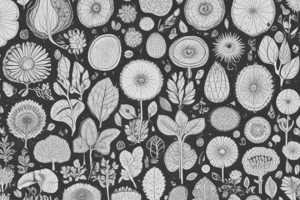Podcast
Questions and Answers
Which of the following cell types provides flexible support to plants, particularly in growing regions?
Which of the following cell types provides flexible support to plants, particularly in growing regions?
- Sclerenchyma cells
- Collenchyma cells (correct)
- Parenchyma cells
- Xylem cells
In a typical dicot stem, how are the vascular bundles arranged?
In a typical dicot stem, how are the vascular bundles arranged?
- Scattered throughout the stem
- Located in the pith
- Concentrated in the cortex
- Arranged in a ring (correct)
What is the primary function of the endodermis in plant roots?
What is the primary function of the endodermis in plant roots?
- Protecting the root apical meristem
- Regulating water and mineral uptake into the vascular cylinder (correct)
- Anchoring the plant in the soil
- Storing food reserves
Which of the following structures is responsible for protecting the root apical meristem?
Which of the following structures is responsible for protecting the root apical meristem?
What specialized cells regulate the opening and closing of stomata in plant leaves?
What specialized cells regulate the opening and closing of stomata in plant leaves?
Which tissue type is responsible for transporting sugars from sources to sinks in plants?
Which tissue type is responsible for transporting sugars from sources to sinks in plants?
What is the function of plasmodesmata found between plant cells?
What is the function of plasmodesmata found between plant cells?
From which part of the flower does a fruit typically develop?
From which part of the flower does a fruit typically develop?
What is the role of the cotyledons within a seed?
What is the role of the cotyledons within a seed?
What is the main function of lignin found in xylem tissue?
What is the main function of lignin found in xylem tissue?
Flashcards
Plant Anatomy
Plant Anatomy
The study of the internal structures of plants, examining them at both macroscopic and microscopic levels.
Parenchyma Cells
Parenchyma Cells
Fundamental plant cells involved in storage, photosynthesis, and secretion.
Collenchyma Cells
Collenchyma Cells
Plant cells that provide flexible support in growing regions.
Sclerenchyma Cells
Sclerenchyma Cells
Signup and view all the flashcards
Epidermis
Epidermis
Signup and view all the flashcards
Roots
Roots
Signup and view all the flashcards
Stems
Stems
Signup and view all the flashcards
Leaves
Leaves
Signup and view all the flashcards
Stomata
Stomata
Signup and view all the flashcards
Xylem
Xylem
Signup and view all the flashcards
Study Notes
- Botany is the scientific study of plants
Plant Anatomy
- Plant anatomy is the study of the internal structure of plants
- It involves examining cells, tissues, and organs at macroscopic and microscopic levels
Cells and Tissues
- Plant cells are the basic structural and functional units
- Plant tissues are groups of cells performing specific functions
Cell Types
- Parenchyma cells are fundamental, involved in storage, photosynthesis, and secretion
- Collenchyma cells provide flexible support in growing regions
- Sclerenchyma cells provide rigid support and may be dead at maturity
- Xylem cells (tracheids and vessel elements) conduct water and minerals
- Phloem cells (sieve tube elements and companion cells) transport sugars
Tissue Types
- Meristematic tissues are zones of active cell division (apical, lateral, intercalary)
- Epidermis forms the outer protective layer of the plant
- Ground tissue includes parenchyma, collenchyma, and sclerenchyma
- Vascular tissue consists of xylem and phloem, for transport
Organs
- Plant organs are structures composed of different tissues, performing specific functions (roots, stems, leaves, flowers, fruits, seeds)
Roots
- Roots anchor the plant, absorb water and nutrients, and store food
- The root cap protects the root apical meristem
- The epidermis is the outer layer with root hairs for absorption
- The cortex is ground tissue for storage
- The vascular cylinder contains xylem and phloem
- Endodermis regulates movement of water and minerals into the vascular cylinder
- Lateral roots originate from the pericycle
Stems
- Stems support the plant, transport water and nutrients, and bear leaves and flowers
- Nodes are points where leaves attach
- Internodes are stem segments between nodes
- Buds develop into new shoots or flowers
- Vascular bundles contain xylem and phloem
- In dicots, vascular bundles are arranged in a ring
- In monocots, vascular bundles are scattered
Leaves
- Leaves are the primary photosynthetic organs
- The epidermis is the protective outer layer, often with a waxy cuticle
- Stomata are pores for gas exchange, regulated by guard cells
- Mesophyll is the ground tissue where photosynthesis happens (palisade and spongy)
- Vascular bundles (veins) contain xylem and phloem
Flowers
- Flowers are reproductive structures
- Sepals protect the developing flower
- Petals attract pollinators
- Stamens are male reproductive structures (anther and filament)
- Pistil (carpel) is the female reproductive structure (stigma, style, ovary)
- Ovules within the ovary contain the egg cells
Fruits
- Fruits develop from the ovary after fertilization
- They protect seeds and aid in seed dispersal
- Fruit types: simple, aggregate, multiple
Seeds
- Seeds contain the plant embryo and food reserves
- Seed coat protects the embryo
- Cotyledons are seed leaves
- Endosperm is the food storage tissue
- Embryonic root (radicle) and shoot (plumule) are present
Vascular Tissue System
- Xylem transports water and minerals from roots to shoots
- Tracheids and vessel elements are the conducting cells
- Lignin provides structural support
- Phloem transports sugars from sources to sinks
- Sieve tube elements and companion cells are the conducting cells
- Plasmodesmata connect companion cells and sieve tube elements
Specialized Structures
- Trichomes are epidermal hairs with various functions
- Glands secrete substances
- Thorns are modified stems for protection
- Spines are modified leaves for protection
- Tendrils are modified stems or leaves for climbing
Studying That Suits You
Use AI to generate personalized quizzes and flashcards to suit your learning preferences.




